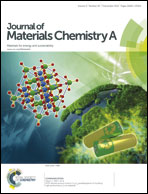One-step chemically controlled wet synthesis of graphene nanoribbons from graphene oxide for high performance supercapacitor applications†
Abstract
The present manuscript for the first time reports a novel one-step wet chemical approach to synthesize about 150–300 nm wide graphene nanoribbons (GNRs) by reduction of graphene oxide (GO) using malonic acid as a reducing agent. Optical, X-ray diffraction, high resolution transmission electron microscopy, Raman, infrared, X-ray photoelectron spectroscopy and 13C nuclear magnetic resonance (NMR) demonstrated the effective reduction of GO. The average thickness of GNRs has been estimated by atomic force microscopy at 3.3 ± 0.2 nm, which is reduced significantly to 1.1 ± 0.5 nm upon annealing at 300 °C (GNRs-300). In the process of nucleation and growth, the intermediate(s), formed between malonic acid and GO undergo twisting/folding involving supramolecular interactions to yield ∼0.15 to 1 mm long curled GNRs. 13C NMR demonstrates a significant increase in the sp2 character of the nanoribbons following the order GO < GNRs < GNRs-300, as also evidenced by the conductivity measurements. GNRs exhibited a high specific capacitance value of 301 F g−1 at 1 A g−1 with good cyclic stability for 4000 charge–discharge cycles at 15 A g−1, and high energy density/power density (16.84 W h kg−1/5944 W kg−1) in an aqueous electrolyte demonstrating their tremendous potential as electrode material for energy storage applications.


 Please wait while we load your content...
Please wait while we load your content...